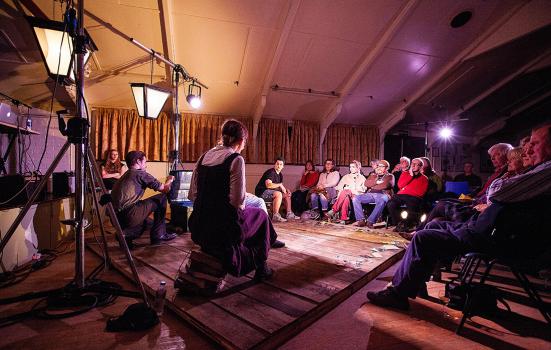Rural touring could win back audiences first, as confidence in village hall venues is higher than for other types of auditorium, research finds.

Confidence in seeing live theatre and productions could start with rural touring productions in community settings.
The Live & Local ‘Restart Audience Survey’ found that the type of venue arts attenders would feel most comfortable walking into first would be a village hall.
The survey was conducted among Live & Local’s 6,000-strong e-mailing list and attracted 702 respondents. 31% said they would have ‘no concerns at all’ about returning to a village hall venue after the lockdown, compared with 22% at a small studio venue and 14% at a medium/large seated venue. Only 5% said they would have no concerns about returning to large standing venues.
One respondent described how they felt about returning to live performances, saying: “I live in a village and we’ve very much gone through this together. I know who has been unwell, who goes where to shop and the general health of my community. I would be much more confident to see a production in my local hall than I would travelling to a larger theatre”
The cost of safety
Holly Lombardo, Director of the National Rural Touring Forum, believes rural touring venues – which attract local audiences who know each other and who often walk to get there – could offer a place for audiences to see shows earlier than urban venues and larger institutions.
She told AP: “The fact that rural touring is local means spaces are flexible, audiences know each other and the artists are generally small in numbers, makes it a very likely they can open earlier. We are taking advice and working with ACRE (Action with Communities in Rural England) on a risk assessment for village halls that incorporates live events”.
NRTF is determined to support artists, stay in touch with local promoters and audiences and offer offline opportunities and creative events that retain the intimacy of a live show and the feeling of a shared experience. But Lombardo warned that this will need “investment and careful thought for that to be safe and successful”.
She continued: “Audiences and promoters in rural areas tend to be older and therefore more at risk and vulnerable to the pandemic, and opening doors will only happen if the communities – and the volunteer promoters who put on the shows – feel safe to do so.
“Distancing audiences 2.5 metres apart will mean a significant loss in ticket revenue, and there will be the cost and time implications of setting up more handwashing stations...Touring budgets will be stretched if performers who would normally stay in local digs have to stay in hotels.”
A place at the table
Rather than specifically looking for funding, Lombardo wants rural touring to have a “place at the table and our voice to be heard as loud as the larger institutions.” She would like to see more “general understanding and expectation of what is needed” to reopen under the current circumstances.
She said: “There are many layers of complexity in reopening, from toilets facilities to interval refreshments, to the seating configurations and number of tickets a space is able to sell. We will need to bear in mind liability in terms of cancellations and illness.
“If a promoter, an artist, or the audiences were unwell and the show couldn’t go on, whoever calls the cancellation is likely to be liable for costs. This adds to the risk factor and financial burdens.
“There are potentially bigger obstacles in the picture too, if we need to provide cashless and online ticketing because of the lack of good rural broadband infrastructure and that rural areas suffer greater barriers to accessing fast broadband and phone reception.”




